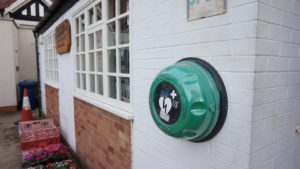 Ashleworth has two AEDs – one located outside the Post Office and the other is located in the changing rooms at Woodpeckers Sports and Social Club.
Ashleworth has two AEDs – one located outside the Post Office and the other is located in the changing rooms at Woodpeckers Sports and Social Club.
AEDs are easily accessed by removing the cabinet cover and they provide simple step-by-step audio instructions for their use. Note that if a cardiac arrest occurs and you use the AED you should also call 999 immediately where an operator will be able to provide assistance as well as arrange for an ambulance
.
The AED at the Post Office was bought and installed with funding from Ashleworth Parish Council and The British Heart Foundation. There is a product information training DVD available to borrow for anyone wishing to check how it works – please contact Nicky Hill the Parish Council Clerk ashleworthpc@gmail.com
Location: Ashleworth Post Office GL19 4JG, what3words: blown.grinning.broccoli
The AED is regularly inspected and its status reported to South Western Ambulance Service on a monthly basis, if however anyone suspects it has been moved or used, please contact the Parish Council Clerk.
The AED at the Woodpeckers was kindly donated and is maintained by G.R. Lane Health Products Ltd (Lanes Health) of Gloucester.
Why are AED’s important?
When a cardiac arrest occurs (when the patient’s heart stops beating correctly and they stop breathing) every second counts. For every minute that goes by the chance of survival reduces by as much as 10 to 14%. But with fast and effective CPR and defibrillation the chances of survival increase hugely, to as much as 85%.
Automated external defibrillators (AED’s) are easy to use, compact, portable and very effective. They are designed to be used by lay persons and guide the operator through the process by verbal instructions and visual prompts. They are safe and will not allow a shock to be given unless the heart’s rhythm requires it. They are designed to be stored for long periods without use and require very little routine maintenance. You will now see AEDs in many public places such as shopping centres, leisure centres, airports and train stations and now also more and more in towns, villages and communities across the country.